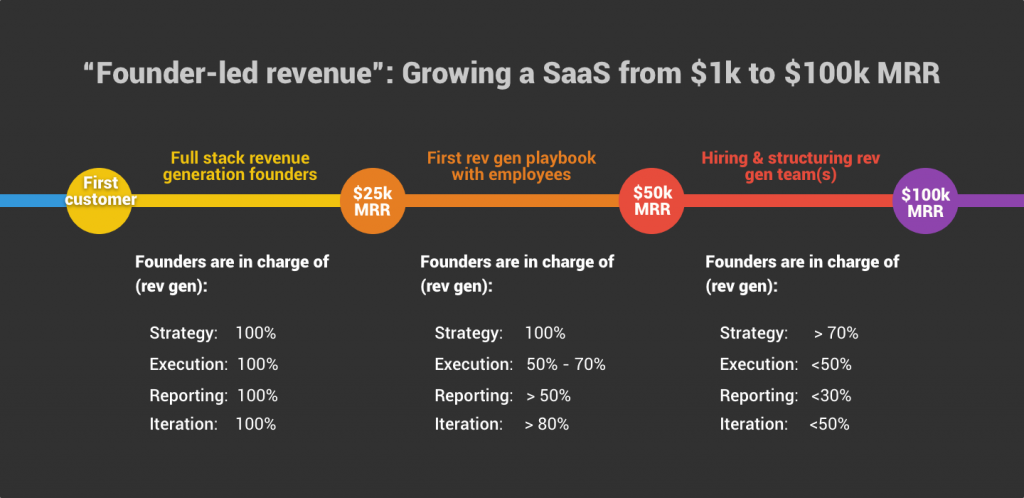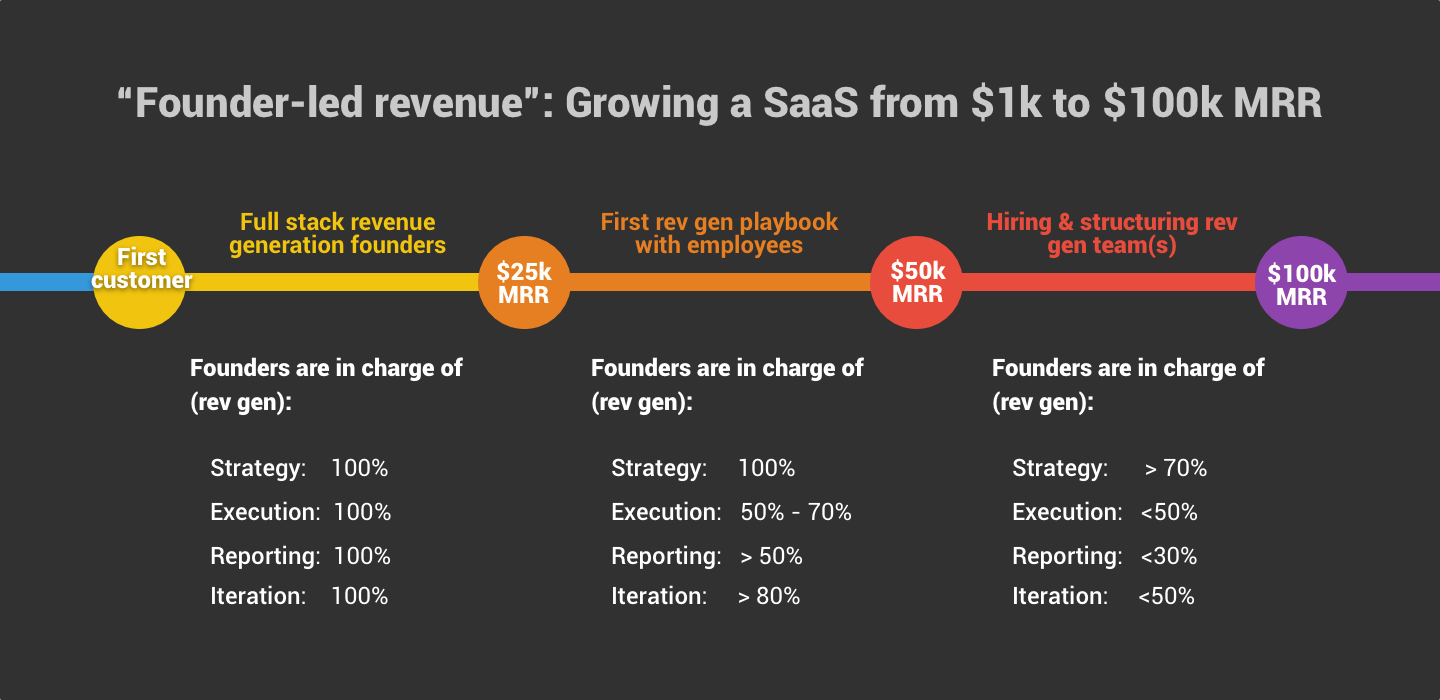The past couple of weeks I’ve been working with several early stage SaaS founders who are in the 0-$10k MRR range. A common theme that came back across these different projects was about why the first $100k of MRR should be “founder-led” revenue versus hiring an experienced person to be in charge of revenue generation (whether a sales or marketing profile). Basically why there’s no escape for founders but to lead revenue generation until the $100k MRR / $1M ARR mark.
What does “founder-led” revenue mean?
From my experience and what I could see in successful SaaS companies, I would break down the path to $100k MRR into three sub-stages:
- From $1k to $20k – $25k MRR
- From $25k to $50K MRR
- From $50k to $100k MRR
And we can break down “revenue generation” into four components:
- Strategy: The strategy that needs to be put in place to generate revenue.
- Execution: The execution of this strategy, a.k.a the tasks that will concretely bring money.
- Reporting: Measuring the results of the execution in order to understand what works and what doesn’t.
- Iteration: The changes and improvements you make to your strategy after analysing your results.
And if you combine both, you get the illustration below where the percentages next to the different “revenue generation” components show how much the founder should be involved for each. For example, “Strategy: 100%” means that the founder is 100% in charge of strategy. “Execution: 50% – 70%” means that the founder should be responsible for 50% to 70% of the tasks in the execution bucket (doing demos, contacting potential leads, writing blog articles for thought leadership etc…). The other 50% to 30% is done by employees.

Obviously these percentages are not based on hard data and scientific measurements (I wish), but more on observations based on my experience. The aim is to give you a broad sense of how directly involved a founder should be until the $100k MRR mark.
From $1k to $20k – $25k MRR: The full stack “revenue generation” founders
From what I saw, if the founders cannot grow the first $15k – $25k of MRR by themselves by being 100% involved in each component then it will be very hard to build a successful company.
This phase is critical because reaching the $25k MRR / $300k ARR mark usually means that you have reached a first product market fit. So it’s not only about the money, but about how the founders manage to find a first formula that works (sales model, early personas, how to reach them, how to close a deal etc…) and which will be the foundation of the revenue generation effort going forward.
Going from “nothing to something” is often the hardest part because you don’t know if you can do it (huge uncertainty). This is why it’s crucial that the founders lead 100% of the effort at that stage as it will also set the tone for the rest of the journey.
From $25k to $50k MRR: Putting in place the first playbook with employees
What from I saw, it’s usually around the 20k-25k MRR mark that you start to have a first repeatable “revenue generation” mini playbook that the founders can put in place by hiring the first sales and marketing employees.
It depends on the context, but these first employees are usually high potential junior profiles who can be generalists (marketing and sales) or focus on either sales or marketing. I rarely see experienced people joining at that stage because it’s still a grind and it makes no sense for most of them to go back in the trenches that early. Of course you do have exceptions, but for sure it’s not the majority of what I see working.
At that stage most successful founders will still lead 100% of the effort on the strategy front as well as the majority of the execution and iteration. Usually they start to offload the most “ungrateful” or repetitive tasks of the execution and reporting (like data collection, sending and following outbound emails etc.) components to the first sales and marketing employees.
Obviously the closer you get to the $50k MRR mark the more employees are hired to help with marketing and sales execution.
From $50k to $100k MRR: Structuring the teams that will be in charge of revenue generation
It’s often during this stage that the founders start to structure the team(s) that will be in charge of most of the revenue generation going forward. They start to hire the first real management level (heads of sales, heads of marketing etc.) and employees who will take over most of the “execution” part.
The founders still lead strategy, but the time they spend on directly generating revenue starts to decrease. They usually spend an increasing amount of time on hiring (at every level) and building the management layer (recruiting and processes) that will help scale revenue generation.
Where does this founder-led revenue come from?
Now the $1M (ARR) question: How do founders generate revenue at these stages?
Founder-led revenue is generated either through direct sales or marketing.
Sales-led revenue: From $1k to $20-$25k MRR the founders leverage their network of contacts to reach potential customers, they do warm or cold outbound, they go to trade shows, they do product demos, they close the sales themselves etc… They basically grind in order to generate this early revenue. I don’t invent anything here, it’s the famous “do things that don’t scale”.
A good question to ask yourself at that stage is how many customers you need in order to reach the $20k – $25k MRR mark. And very often it’s not an absurd amount of customers. It’s often a number that you can hit by doing direct sales yourself.
Usually once you reach that stage you have a first repeatable mini playbook that you can use to grow to $50k MRR (you don’t need 10 different playbooks at that stage).
Marketing-led revenue. The other way to generate early revenue is with marketing. And here I see mainly two successful setups:
- One of the founders is outstanding at personal branding and manages to stand out from the crowd thanks to a unique voice and amazing content (social media, videos, blog posts, podcast…). They can generate a ton of attention and attract leads that they close through a low touch model or through direct sales.
- Or there is an obvious marketing distribution channel that can be leveraged and one of the founders is very good at it. It can be mobile app stores, software marketplaces (ex: Chrome or WordPress app stores for a plugin), paid ads in the rare cases where leads have a clear intent to buy and you can capture them at the search phase (it’s rare or hyper crowded nowadays). The important point is that this distribution channel is usually “obvious”.
So I’m sorry to disappoint you, but there is no secret here. What often makes the difference in the $1k-$50k MRR range is not a secret sauce but the drive, execution/iteration speed and perseverance of the founders.
I often use the analogy with sport. When you start a sport (tennis, football, basketball whatever), there is no shortcut at the beginning. You need to grind and persevere to build strong foundations. There’s no secret technique, fancy equipment or other things that will help you get better faster: You just need to practice over and over again until you get good at it. It’s the same with early revenue, you need to grind and persevere in order to get to the first thresholds.
Misc comments
- From what I saw, the vast majority of founders reach the $25k MRR mark with a sales-led approach rather than a marketing-led approach. Founders exceptional at marketing are much, much rarer.
- Having experience in marketing or sales is for sure an advantage, but I saw many first time founders succeed because they were fast learners and were relentless in their execution.
- Big picture, there are mainly two reasons to fail to reach the first threshold:
- Failure to find a strong PMF: if you grind but it’s super super tough to grow your, then you haven’t found a PMF yet.
- Failure on the execution side: The founders are reluctant to get their hands dirty or think that they can hire an experienced person who will do it for them.
